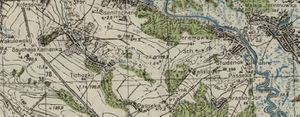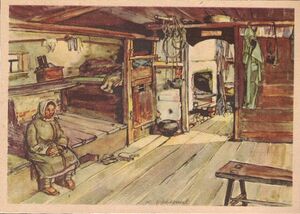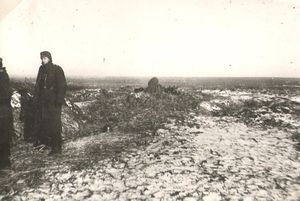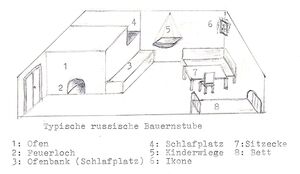12. November 1941
| GEO INFO | ||||
|---|---|---|---|---|
| (Isjum) | ||||
The next morning I step out of the house and cannot believe my eyes: it is freezing cold. Literally overnight the mud period has turned into hard winter weather.[1] The mud that was still being churned up by our vehicles yesterday has frozen as hard as a rock. Our vehicles are frozen in foot-deep mire and cannot be moved. Winter comes on so unexpectedly, and that is not uncommon in Russia. Mid November[2]: minus 15 degrees Celsius (5°F) frost. And it stayed that way.

Yesterday I visited the mortar emplacements I have set up on the reverse slope of the hillside. Today I walk across the huge broad ridge of the elongated slope to my machine gun positions. An icy wind whistles across the height. The machine gun emplacements are so far forward that they can see a large part of the Donets valley. Diagonally below us it lies. A valley kilometres wide, a vast plain with extensive forests. On the left[4] in the distance lies Isjum in a large meander bend of the Donets.
Unfortunately, we are not alone up here. The ridge is still at least a kilometre wide even here at altitude, so that one can almost speak of a plateau. And on the east side of this broad ridge are Russian positions, in fact near a trigonometric point[5]. Sometimes we see an Ivan walking around over there. One day I once had the position shelled by our mortars, and the trig point was a good aiming point for us. The Iwans noticed this immediately and tore the trig point down.
Our machine gun sites up here consist only of small rectangular pits 40 cm deep. The Hungarians had still dug them. The men put a roof of straw sheaves over these pits. Because of the bitter cold, they also kept a small open fire underneath. Of course, this could not go on for long, and in fact one day the roof over their heads burnt down. Now they are freezing again.

Machine gun and mortar squads stay up here on the windswept heights for a week at a time. Then they are relieved and also move to the village for a week, where they can rest in their warm quarters. I myself live with Sergeant Spremann in a small house that consists only of a living room and kitchen. Almost a quarter of the living room is filled by the large clay-plastered stove, on which there is also a place to sleep.
These warm sleeping places are a practical invention in the freezing Russian winters (see sketch opposite).
Four of us live in the little house. The young Ukrainian sleeps in bed, his wife on the stove bench and we two sergeants on a straw bedding on the floor.
The village is an elongated row village. In the middle of the village a few houses are missing, so that there are actually two parts of the village.The village road is in terrible condition. The deeply rutted wagon tracks are frozen as hard as stone. You can break your bones.
During the day I'm out a lot. Either I visit the far-flung positions and strongpoints, or I sometimes go to the men's quarters. One day I am called to a house opposite my quarters. One of my machine gunners had been hit by a stray bullet on the village street as he was going into the neighbouring house. Now he is lying on the floor of the farmhouse parlour. His breath is stertorous and from time to time gurgling and snoring sounds come from his blood-filled mouth. The doctor is notified, but the soldier can probably not be saved. I send the men into the next room, because the death throes of this poor comrade are terrible to hear. The faces of the room-mates seem indifferent, but they don't speak a word the whole time. One was sitting at the table writing a letter.
In my neighbouring house there is a different atmosphere. A very pretty, black-haired girl with a Madonna parting often appears here to visit her aunt. I have also had a conversation with her. She is very cuddly.
Sergeant Sasse is furthest away with his machine gun squad. It is a dangerous corner he guards. A small transverse valley opens out here, through which the Ivans often try to penetrate under the cover of night. The last houses in our village are here right up to the valley exit, so that when Ivan enters the valley, he is already in the first houses. The inhabitants have therefore already left these houses. It is too hairy for them. Sasse now flanks this valley entrance with his machine gun from the neighbouring height. He sits on the upper edge of the valley slope in a front-hanging position and has a good view of the valley entrance, but on the other hand he can also be seen by the Russian.
|
Editorial 1938 1939 1940 1941 1942 1943 1944 1945 1946 1947 1948 1949 Epilog Anhang |
|
January February March April May June July August September October November December Eine Art Bilanz Gedankensplitter und Betrachtungen Personen Orte Abkürzungen Stichwort-Index Organigramme Literatur Galerie:Fotos,Karten,Dokumente |
|
1. 2. 3. 4. 5. 6. 7. 8. 9. 10. 11. 12. 13. 14. 15. 16. 17. 18. 19. 20. 21. 22. 23. 24. 25. 26. 27. 28. 29. 30. 31. Erfahrungen i.d.Gefangenschaft Bemerkungen z.russ.Mentalität Träume i.d.Gefangenschaft Personen-Index Namen,Anschriften Personal I.R.477 1940–44 Übersichtskarte (Orte,Wege) Orts-Index Vormarsch-Weg Codenamen der Operationen im Sommer 1942 Mil.Rangordnung 257.Inf.Div. MG-Komp.eines Inf.Batl. Kgf.-Lagerorganisation Kriegstagebücher Allgemeines Zu einzelnen Zeitabschnitten Linkliste Rotkreuzkarte Originalmanuskript Briefe von Kompanie-Angehörigen |
- ↑ On the 11th light night frost, on the 12th light frost, on the 13th heavy frost; traffic situation improved by frost (KTB 257. I.D., NARA T-315 Roll 1804 Frame 000318)
- ↑ in the original text “October”, unclear whether in error or as an example
- ↑ Russland 1:100.000 sheet M-37-99 Isjum at MAPSTER
- ↑ when looking towards the front, strictly speaking north-north-west; in the original erroneously “right”
- ↑ A wooden survey tower signalling the actual trigonometric point (trig point) was popularly known as trig point itself
- ↑ Original title: SOWJET CULTURE // war reporter Hensel, Erich Gutjahr Bildverlag, Berlin, order-no. 91
Unfortunately, I cannot remember whether it was my father who acquired this postcard and enclosed it with the diary, or whether I discovered and bought it myself long before I actually started editing this diary.


